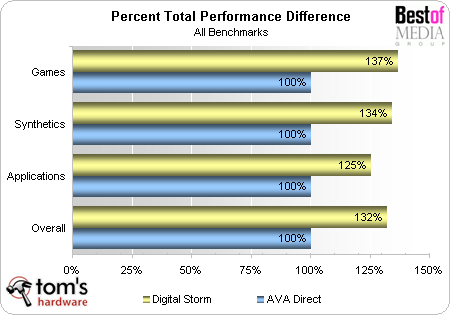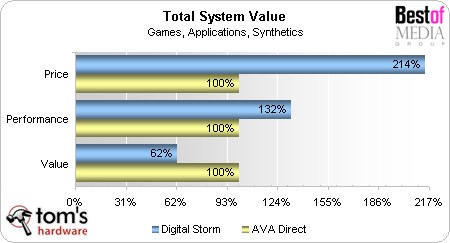Boutique Graphics PCs Duke It Out
Conclusion
Before we perform a value analysis, let's dust off the abacus to see what the overall performance difference is between these diversely priced systems.
Given that these are game machines, we'd expect the largest performance difference to be found there. It's important to remember that even though the Digital Storm Twister Extreme averaged "only" a 37% lead in games, its peak lead of around 100% in each game occurred at the highest quality and resolution settings, which should please visual quality fanatics.
Our Digital Storm Twister Extreme configuration added up to $6,535, including overclocking service fees, while the AVA Direct system came out to a far more palatable $3,054.50. How does the added gaming performance of the Digital Storm unit compare to its added price?
The Digital Storm Twister Extreme cost 114% more, but provided only a 37% average gaming performance gain across all tested resolutions. Quality enthusiasts will note that it also had an approximate 100% gain at the highest settings, so perhaps it's worth the extra money in special circumstances.
But what if gaming is only part of your daily system routine? We averaged all the performance differences to get a feel for overall value.
The lower-cost AVA Direct system leads the Digital Storm Twister Extreme by 28% in overall value, so it's a better deal for anyone who fits within its budget range. The Twister Extreme will still be worth the added expense to high-budget gamers, simply because of its capabilities at high resolutions.
You'll also pay a bit for exclusivity: the AVA Direct system comes with a dual-fan custom side panel that probably lowers cooling performance, because it replaces the case's stock 4-fan bracket and mesh side panel. Obviously, the Plexiglas is used only for visual enhancement. Speaking of which, the Digital Storm arrived with a beautiful red finish (now available with multi-tone graphics) and included the optional Cold Cathode Tube lights.
Get Tom's Hardware's best news and in-depth reviews, straight to your inbox.
Part of the Digital Storm's added cost is its more elaborate CPU cooler, which is likely a requirement of the harder-to-overclock Core 2 Extreme processor. Four cores suffer more greatly from hotspots that can limit clock speeds, and we can't fault the company for compensating.
The "best buy" for any particular user will obviously depend on his or her budget, but both of these systems performed extremely well for their hardware configurations. Making the choice even more difficult is that both companies are able to match the configurations of their competitors, so if you'd like to have a Digital Storm version of the AVA Direct System, it's completely within the realm of possibility.
Both companies offer a three-year warranty. Digital Storm goes a little further by adding lifetime telephone tech support, but we don't expect anyone who can afford such a system to keep it around longer than the three years of its full warranty. Still, it may become valuable if you have a habit of handing off, er, "loaning", old systems to family members while "retaining ownership".
We liked both machines, and cannot recommend against either, since they both performed flawlessly. That said, being a bit on the cheap side, we can't really say we'd pay even as much as $3,000 for a system. Your purchasing decision must be based on your own concept of value and worth, of course.


